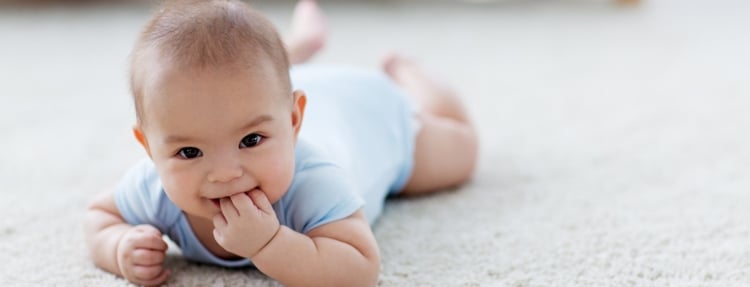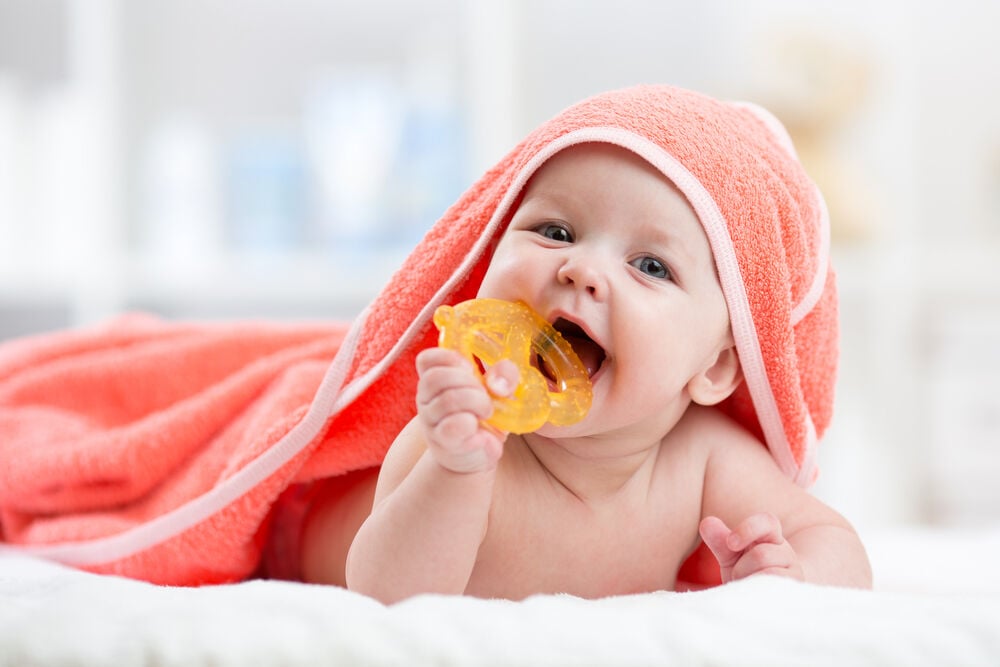From pediatricians to parenting blogs, the phrase “every baby is different” is quite common. Despite this, it’s normal for parents’ instincts to go into overdrive whenever they think something unusual is going on with their baby. So, is it normal if a baby starts teething at 3 months old? Read this article to find out!
-
Tracking cycle
-
Getting pregnant
-
Pregnancy
-
Help Center
-
Flo for Partners
-
Anonymous Mode
-
Flo app reviews
-
Flo Premium New
-
Secret Chats New
-
Symptom Checker New
-
Your cycle
-
Health 360°
-
Getting pregnant
-
Pregnancy
-
Being a mom
-
LGBTQ+
-
Quizzes
-
Ovulation calculator
-
hCG calculator
-
Pregnancy test calculator
-
Menstrual cycle calculator
-
Period calculator
-
Implantation calculator
-
Pregnancy weeks to months calculator
-
Pregnancy due date calculator
-
IVF and FET due date calculator
-
Due date calculator by ultrasound
-
Medical Affairs
-
Science & Research
-
Pass It On Project New
-
Privacy Portal
-
Press Center
-
Flo Accuracy
-
Careers
-
Contact Us
Can Babies Start Teething at 3 Months? Signs and Useful Tips

Every piece of content at Flo Health adheres to the highest editorial standards for language, style, and medical accuracy. To learn what we do to deliver the best health and lifestyle insights to you, check out our content review principles.
Can babies start teething at 3 months?
While most babies start teething when they’re about four to six months old, this doesn’t apply to every baby. Some babies are born with a tooth or two, while others reach their first birthday with no teeth at all. Occasionally, some babies start teething before they’re four months old, but that doesn’t mean that there’s anything wrong with them.
Teething at 3 months: main signs
Regardless of when a baby starts teething, the emergence of teeth is usually accompanied by similar signs. The most common signs of teething include:
- Increased drooling — Drooling is normal in babies, but it tends to increase as teeth get closer to emerging. Excessive drooling can cause a rash on the baby’s chin, neck, and chest area. If the baby is drooling more than usual, fastening a bib around their neck or applying a thin layer of petroleum jelly on these areas can help prevent rashes. Wiping their drool frequently will also help keep them clean.
- Irritability — Teething babies tend to become fussier than usual. This is because as teeth erupt, they erode the gums and cause discomfort. The baby could express their discomfort by crying or whining. However, they should get used to this feeling quickly and become calmer. If the baby is too irritable, their pediatrician can also prescribe a pain reliever.
- Swollen gums — Since erupting teeth erode babies’ gums before they completely emerge, it’s normal for their gums to be somewhat swollen in the days before teething. The baby’s gums could also have small bruises or some redness. Gently rubbing a cool, wet cloth over their gums or providing a teething ring made of firm rubber to chew on can help provide relief.
- Decreased appetite — If a 3-month-old is teething, suckling to eat could make their gums hurt more. This could cause a decrease in their normal eating patterns while they’re teething.
- Mild fever — Teething won’t cause a high fever, but it could lead to a mild increase in the baby’s body temperature. This shouldn’t exceed 100.4 degrees F (38.0 degrees C). Any fever in a three-month-old requires a trip to a health care provider, even if they’re teething. Talk to the baby’s pediatrician to rule out more serious causes of fever.
Remember that teething won’t cause serious symptoms, regardless of the baby’s age. So if a child has diarrhea or a high fever, it’s time to call the health care provider, even if they’re teething at the same time. Irritability caused by teething can be stressful for new parents who are already battling postpartum symptoms or postpartum depression. But the important thing to remember is that teething will pass, and the baby will likely feel better soon.
How can teething at 3 months affect breastfeeding?
If a three-month-old is teething, it’s normal to wonder what that will mean for breastfeeding. When the unavoidable happens and the baby bites down on the breast, calmly unlatch them, say immediately and firmly “No,” and take a little break from nursing. It may happen several times, even before their teeth fully emerge, but it will work. Using the same words and tone each time will help them get the message.
It’s also important to make sure that the baby has latched on correctly. When they’re in a good position to breastfeed, it becomes less likely that they’ll bite while eating. Positioning the baby so that the nipple is aimed toward the roof of their mouth and the baby’s tongue is between their lower teeth and the breast is ideal for breastfeeding. Additionally, making sure to remove them from the breast immediately after they’re done nursing can help keep them from biting.
If the baby bites too frequently, consulting with a lactation consultant may help.
Three things to help a baby teething at 3 months
If a 3-month-old is teething, there are many items available that can help ease their discomfort, like teething mittens and hand teethers.
Teething mittens
Many babies like to chew their hands while they’re teething. If a three-month-old can’t hold objects and put them in their mouth yet, a teething mitten could be the solution. The teething mitten fits over the baby’s hand, and they’ll be able to chew on it happily for hours on end, without having to hold the object itself.
Teething mittens are also great for sensory stimulation since they feature bright colors, varying textures, and a silicone surface that will soothe their symptoms.
Hand teether
Hand teethers are small objects that are shaped and designed specifically to soothe babies’ aching gums. As their name suggests, they are shaped like hands and filled with water or another liquid. They can be placed inside the fridge, and once cool, their temperature provides extra relief for swollen gums. Their “fingers” are perfect for babies to safely scratch every nook and cranny of their gums.
Teething pacifier

Take a quiz
Find out what you can do with our Health Assistant
Teething pacifiers are very similar to regular pacifiers, with a few modifications especially for teething babies. They’re made of silicone, which is more resistant to babies’ bites than other materials. They also tend to feature different textures that soothe babies’ gums while stimulating their mouths.
At the end of the day, it’s perfectly normal to have a three-month-old teething baby. While it’s a bit earlier than expected, their teething won’t have any negative effect on the rest of their development. More than likely, the baby will be done teething soon and continue their development.


Hey, I'm Anique
I started using Flo app to track my period and ovulation because we wanted to have a baby.


The Flo app helped me learn about my body and spot ovulation signs during our conception journey.


I vividly
remember the day
that we switched
Flo into
Pregnancy Mode — it was
such a special
moment.
Real stories, real results
Learn how the Flo app became an amazing cheerleader for us on our conception journey.




